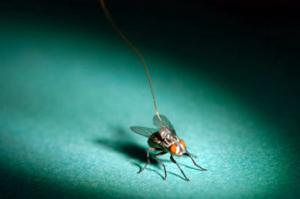When they fly, insects use their vision for piloting, just like human pilots. The electric signals from their facetted eyes travel through specialized neurons to stimulate the wing muscles, which let the insects correct their flight and avoid crashes. Could these same neurons be used in a sort of "automatic pilot"?
This is what Nicolas Franceschini, Franck Ruffier and Julien Serres have just shown. These biorobotics specialists from the Movement and Perception Laboratory (CNRS/Université de la Méditerranée) in Marseille, France have revealed an automatic mechanism called the "optic flow regulator" that controls the lift force. The researchers obtained these results by modeling the overland flight navigation of insects using experiments carried out on OCTAVE, a captive flying robot microhelicopter that can reproduce much of the mysterious natural insect behavior. Their work is published online in Current Biology, February 8, 2007.

How does a tiny creature like a fly or a bee, with a brain the size of a pinhead, manage to make such a magnificent job of controlling its flight, and avoid crashing to the ground?
Today it is known that the sensory motor prowess of these flying miniatures depends on the nervous system, made up of between one hundred thousand and one million neurons. When an insect, bird or pilot flies over land, the image of the ground below sweeps from front to back across the central part of the visual field, creating an "optic flow", which is defined as the angular speed at which the ground contrasts move past. By definition, this angular speed is equal to the ratio of the horizontal speed and the altitude. What these authors call an "optic flow regulator" is a reflex that keeps the optic flow, and thus the speed/altitude ratio, at a constant value. If the insect changes speed, this reflex will make it change altitude so that ratio remains constant. Adjusting the speed/altitude ratio means that the insect has no need to measure either its speed or its altitude.
If there is a strong headwind, its forward speed will be reduced. Thus its optic flow regulator will constantly force it to reduce altitude so that the optic flow always remains at the reference value. The insect has to make a forced landing against the wind, but a safe landing, because it takes place at a vertical speed of zero. Reactions of this type to a headwind have been described countless times in insects and even in birds. They are also observed on the microhelicopter each time it faces a laboratory-produced headwind, reinforcing the hypothesis that flying creatures have an optic flow regulator.
The very simple control scheme proposed takes into account 70 years of often surprising observations of the behavior of winged insects. It accounts for the fact not only that insects descend facing a headwind and ascend with a tailwind, but also that honeybees land with a constant slope and drown when crossing mirror-smooth water1.
Behind this astonishing behavior, hidden in the insect's cockpit, are movement detector neurons that act as optic flow sensors. The team patiently decoded the functioning of these neurons using ultra-fine microelectrodes (with a diameter of a thousandth of a millimeter) and a specially designed microscope. They then produced an electronic microcircuit based on this principle. The most recent version weighs only 0.2 grams. This is the neuron that does most of the work on board the microhelicopter.
The optic flow regulator helps explain how an insect manages to fly, even in unfavorable wind conditions, without measuring its ground height, groundspeed or descent speed, in other words without using any of the usual aircraft onboard flight aids like radar, GPS, radio-altimeters and variometers. An insect brain wouldn't cope with these cumbersome, heavy, energy-consuming devices.
This important work shows that this new science called biorobotics, that the team from Marseille started in 1985, is important both for fundamental and applied research. The method consists in using robotics models to test biological principles that are perceived only vaguely at the outset.
These hidden forces underlying animal behavior can then be understood more exactly by permanently shuttling between biology and robotics. These principles have been tried and tested for millions of years, and today they need to be applied to aerospace, because the phases in which an airship or a space module navigates close to the ground are absolutely crucial.
The researchers and CNRS have filed an international patent for the "fly automatic pilot".
1. When ripples are totally absent from a pond surface, for example, the (natural and artificial) optic flow sensors are put out of action because there are no contrasts. This results in insects being drawn irresistibly downwards.
Reference: A bio-inspired flying robot sheds light on insect piloting abilities, Current biology 17, 4 (February 20). Franceschini, N., Ruffier, F., Serres, J. (2007).
Note: This article has been adapted from a news release issued by CNRS.





Comments